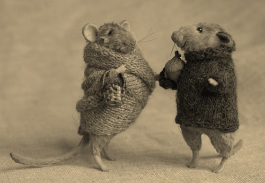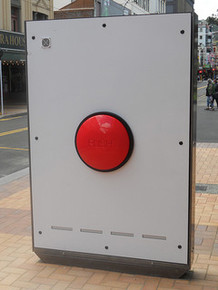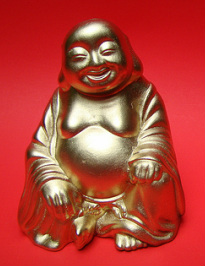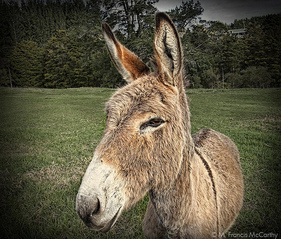 Two Mice/Natasha Fadeeva Two Mice/Natasha Fadeeva At the same time I looked forward to sitting in the darkened Castro Theatre with my sweetie, holding her hand through the scheduled films at the Frameline Film Festival, I dreaded the wait time in line, intermissions, almost any occasion calling for light conversation. It had become clear to me that in this respect we were struggling.
Without diversions like movies, plays, music, I have been afraid that our equanimity might run out around showing an honest interest in the other’s mental preoccupations. One day I showed up at the theater to find her saving a place in the member’s line, and my mind was still mulling over Pema Chodron’s talks on hopelessness as the first step toward liberation and Corky had listened to chapter four of a Dave Egger’s audio book and was eager to regale me. Unfortunately, her enthusiasm had not been contagious. I was brain deep in nonbeing and eager to become unconditionally friendly with the pieces of myself I didn’t much like.
Additionally, I haven’t been able to do companionable very well grappling with notions of self and not self. It is a lose-lose proposition. For example, the day we sat in a darkened row in the Castro a few minutes before the screening of “But I’m a Cheerleader,” I recognized a disconnect in the making. Arriving before Corky, I chose a seat and an adjoining seat in a row behind friendly women. It had been fun working out which of them was taller from the waist dow n and would not block our views. I enjoyed the camaraderie and also took note that none of the women had what I term irresponsible hair, the kind that kinks or curls in all directions, blocking visual access to anything but the hair. I was satisfied with those seats. When Corky arrived, she asked me if I wanted her to move over a few seats. Perplexed by the question and a mite irritated, I told her I didn’t want anything but for her to sit down. I explained that I had not haphazardly picked this particular seat or row. Thought had gone into this choice.
In all fairness, Corky’s willingness to move was grounded in memories of many events we had attended at which I had grumbled about being seated behind the tallest person in the world. In her current wish to prevent such unpleasantness, she referenced previous experiences at the same time I was shaping this one. My current self was satisfied with the seating arrangement; whereas kindness had led her to default to a memory of my earlier disappointments and to act on it.
This moment of irritation was followed quickly by another tussle between self and not self, between the self I thought I was being at that time and the self she imagined she was sitting next to. Not the same selves. Her question of when I had seen this movie the first time was met with my noncommittal reply, a response full of fuzziness and dismay at not knowing the decade, let alone the year, I had first seen the film. Corky heard me criticizing her for asking a nonspecific question about “when.” I was surprised to hear that I was being argumentative and competitive when neither attribute applied at that moment. Her experience and mine just didn’t match up. Maybe that’s the way it is to be human, minute-by-minute.
Of course, not every shared experience is a struggle. Many of our side-by-side times are peaceful and hand-holding, comfortable and comforting. I am on my way to accepting that conversations about nonbeing may not be endlessly interesting. Nor would I dare suggest that she find the value of hopelessness or the conundrum of self and not self more worthwhile than any book by Dave Eggers. With a little distance, I can see the humor in pitting my interpretation of reality against Corky’s. That’s all they are anyway: interpretations.
 Push/Kristina D.C. Hoeppner Push/Kristina D.C. Hoeppner We all have buttons. Mine is red primarily because the pain is intense. It is the color of danger and detonates (from Latin detonare, to expend thunder) when pushed. This button is hooked up to shame. I can’t think of anything good to say about this button except that it is mine as a gift of my upbringing. For me, shame is a hundred times worse than having the rug pulled out from under me. It is me as a child, reaching out for love and seeing my mother’s frowning face and instead of being held, I am told I smell bad. Feeling shamed undoes trust.
My shame button packs a wallop bigger than any event in the present might warrant. And the resulting blast can blow back the deliberate or inadvertent button-pusher at the same time as I am reeling. Eventually I recover and the pain abates, but the button-pusher may take longer to recover, maybe never. When “never,” a friend is lost.
I had occasion to share an impromptu drawing of this big red button with Corky a day or two after we got back from our Wednesday through Monday trip to Ashland. I wanted her to visualize what got triggered when she responded to my joke about my parking by reacting angrily, bringing up similar moments from our trip. I felt blindsided. I had been imagining we were getting along well.
Blast! Off went my button. I am sure Corky had plenty of reasons to find me annoying and to get her own buttons pushed during our seven hour ride to Ashland, the six days we were together seeing theater and the long ride back.
But the time she chose to air resentment was days after the offending behavior. We were on our way to a movie in the city when I remarked on her choice of a parking place. True, it wasn’t smart and she does drive her own little Mini quite well, but rather than limit her objection to my present remark, she hooked her rancor to all the days we were in Ashland behind the wheel of her son’s car. Oops, the rug was being pulled out from under me. I felt shame that I hadn’t been aware of how she was really feeling.
Larry’s car, the one we drove to Ashland, is a manual shift car. It is fairly new and in pristine condition. Thus both Corky and I were hyperaware of driving carefully, and we were both inclined to be always behind the wheel regardless of who was driving. Needless to say, many suggestions were made, some in voices of alarm. Under the circumstances, I welcomed her help because I don’t usually drive a manual car.
Two years ago I fled the scene of a red-button pressing. This time, I stood on the street and breathed mindfully, hanging out in my prefrontal cortex and not running, although I could hear my reptile brain calculating the distance to the nearest bus line. Meditation practice has made it possible for me to pause and feel miserable for shorter periods of time without trying to flee from the pain.
Don’t get me wrong. Corky’s complaint was legitimate. If she has trouble with comments on her driving, as many people have when their loved ones backseat drive from the passenger’s side, I get it. It’s the older complaints that push my button. I know I can be annoying. And I don’t mind being told in a timely way so I can apologize and make amends. I even thanked Corky once when she told me I was annoying, minutes after she was annoyed. I like knowing where I stand and hate thinking I’m on solid ground when that isn’t the fact.
As Buddhism teaches, holding on to certainty is going against the truth of life as it is. So I am wondering if a time will come when with continued practice, this big red button will shrink or fade even further. No one will need to be different and I will not seek solid ground. Losing my footing will not trigger shame.
 Gold Buddha /VasenkaPhotography Gold Buddha /VasenkaPhotography Awards for the “Best” of anything are not pro forma at the Zen Beginner’s Mind Temple (Hosshin-ji), also known as City Center. Had there been an award for Beginningest Mind given the Saturday that was my first all-day sit, it would have been mine.
Actually, the award was mine even before I left the house—from the moment I reached into my closet and grabbed a white, hooded windbreaker. Had I thought before I grabbed white, I would have remembered never having seen colors other than black, brown, navy blue or forest green – always some variation of a somber hue. In past visits to the Zen Center, I, too, kept a low color profile.
Outside my building at 5:10 a.m., I met my Zen practice teacher, Rev. Keiryu Liên Shutt, to walk to the Zen Center together, and she didn’t take notice. She could have been thinking: This may be Alison’s first “one-day sit” but it is not her first time meditating at Beginner’s Mind Temple. Surely she won’t wear white inside. More likely, Liên was eager to be on time to change into her own black robes.
By skipping the preceding night’s introduction to a one-day meditation session for beginners at City Center, I wasn’t informed about clothing, routines or even how to read the day’s schedule. While the references to time wouldn’t require clarification, those Sanskrit or Pali words that explain what to do and where to go would just be Sanskrit or Pali to me.
Knowing what to do when might have kept me from trailing after the kitchen staff heading upstairs from the hall outside the zendo where I sat. Late registrants sit in this entry hall. Meditating with my eyes open for the first time, I saw them leave. Not knowing who they were, what they knew that I didn’t, why they got up or where they were going, I followed. In the kitchen I stood barefooted in my white windbreaker. Eventually, one smiling staffer asked me what I was doing in the kitchen. At that moment I uttered what probably clinched the Beginningest Mind award for me. “I don’t know,” I said, sounding neither wistful nor shameful, but simply truthful. They asked me where I was supposed to be. Again, “I don’t know.”
Not knowing on this day of silence became an adventure in living with beginner’s mind, a low-level pervasive uncertainty. Many times before the day was over, I would rue my decision to skip the beginner’s orientation. Finally, to avoid uncertainty escalating into distress I importuned the man in the bookstore. Surely, he was not observing silence, and he might be willing to translate the day’s schedule for me. This he did, but not before reminding me that talking was not permitted and though he was talking, I must not. Thus when we came to the posted schedule, I pointed and he whispered.
Later in the afternoon, I was helpless to silence my bubbling laughter while scrubbing mirrors, sinks, and tubs in the second-floor women’s restroom—the work detail to which I was assigned. I delighted in the irony of it as I mopped the floor and pulled matted hair from the sponge mop. The young resident in charge was willing to hear the why of my laughing. Yesterday, two women cleaned my own small condo because I don’t like housework. Of course they were paid. And wasn’t it funny in a wonderful way that here I was the next day cleaning up after others as part of a day of meditation for which I had paid. “Every activity is part of the practice,” she whispered in response.
And only once during the day did my Zen practice teacher, Liên, feel compelled to whisper instructions to be sure I didn’t muck up an activity of great formality on my way to winning the Beginningest Mind award. She told me to stay behind one of her experienced friends and do whatever she did.
Unfortunately, before going upstairs to procession into the Buddha Hall behind my guide among all the black robed sitters, I grabbed my white windbreaker, rolled it as small as I could and stuffed it under my left arm. There it stayed through the ceremony presided over by Central Abbot Myogen Steve Stücky. Each time I prostrated myself among the others, I flopped sideways, gripping its whiteness to my side. Twice I felt my feet touch the head of the woman behind me as I wriggled awkwardly to standing, the jacket clutched beneath my arm. Even when it was my turn to ask the Central Abbot a heartfelt question about my meditation practice, I stood before him with the crumpled white windbreaker under my arm to ask him, “Where is wrong?”
Every misstep, timing error, or misunderstanding has not been recounted here. And in spite of these and other miscalculations, I felt great gladness. I had maintained my equanimity, sat still on my chair facing the white wall each meditation period and understood most of an esoteric dharma talk. Moreover, I felt genuine kindness toward my blundering. All in all, it was a very good day; not only was I a frontrunner for the Beginningest Mind trophy, but also a contender for the “Mighty Kindness to the Self” award.
 Donkey/M Francis McCarthy Donkey/M Francis McCarthy I value interpreting dreams. I prefer the soaring above rooftops dreams over the ones with me running a few steps ahead of screaming adolescents brandishing switchblades. I have sweated and twitched through such terrifying dreams as well as awakened refreshed by reassurances of my essential worth. A few dreams stand out as having given me insight and direction.
These significant dreams stayed with me, at first urgent to be understood. Arising from the unconscious, they presented themselves visually as clear and present as a painting.
Such a recent dream was on my mind as Corky and I took advantage of the free days at MOMA, and headed for the modern painters. I wanted to look at Surrealist paintings and their dreamlike quality and so lingered in front of Magritte’s “Personal Values.” The artist has altered the scale and size of ordinary objects while the blue sky and puffy white clouds look inside the room as well as outside. Meanwhile, Corky contemplated Diego Rivera’s charming picture of a peasant child. Eventually, we viewed most of the art on the second floor, and all the art suggested the potency of dreamlike distortion.
Back from the museum, I called my sister who has worked with dreams and asked her to listen to my dream and help me “get it” as I sensed it held special wisdom for me. She reminded me that it’s helpful to consider every person, animal or object as an aspect of my own energy or myself. After telling her the dream, she asked me to repeat it using personal pronouns for the people or animals in the dream.
Here’s the dream as it relates to my own energy: I have an aspect of myself that wants to create and the dream says I will not be able to use my youthful creative energy, represented by a group of unruly young people, unless I ride a small grey donkey. Only one donkey stands in a corral. I refuse to ride it, convinced I would look a fool. But a higher authority insists I ride it. The grey-brown donkey appears compliant. It’s not a powerful, flashy snorting steed, but a drab, humble creature whose work is to carry me. Reluctantly, I get on and wrap my arms around the donkey’s neck. No saddle, no reins. Immediately, we are running fast and going downhill as if on Fillmore heading toward the Marina but with no cars, bus lines or buildings, just clear sky. I hold tight.
I can do nothing but trust the donkey as it races downhill at breakneck speed. Then as suddenly as it has been going fast, it stops at a red traffic signal. At that dream moment I can’t believe the donkey is this clever. Cheering onlookers appear from side streets and my students gather around me, full of respect. They implore me to teach them. I tell them their work is to write and they go back to school, willing to follow directions.
My dream donkey being the central image in the dream, I began with appreciating its (my) willing and compliant nature—obedient, ordinary, and patient. I thought of this line in Mary Oliver’s poem “Wild Geese:” “You only have to let the soft animal of your body love what it loves.” I experienced in my body that loving softness which was like the feeling I had when I was being Grandma Alzie to Baby Theo, holding and rocking him as he slept in my arms.
One donkey left in the corral represents reluctance and resistance; it is the part of me that doesn’t like to be told what to do. I surmised that the other teachers had already done what they were told. The dream tells me that I, too, having done what I was told now know the steady energy I need to do creative work. Apprehensively, I accept the meaning of the dream. Acknowledging capability scares me more than giving up on myself. Making excuses has been much easier than making art.
With my sister helping me work with my dreams, the Surrealist Magritte inspiring me to blending the inner and outer worlds and Corky insisting that the unlived life is not worth examining, I think I might, as artists do, risk becoming disciplined and steadily create. Who knows what might come of it? Meanwhile, time passes.
|
 Two Mice/Natasha Fadeeva
Two Mice/Natasha Fadeeva 


 RSS Feed
RSS Feed